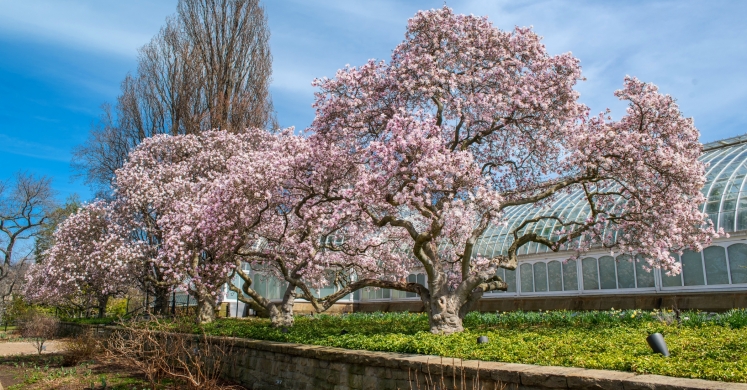Blog

#bioPGH Blog: Magnolias
 A resource of Biophilia: Pittsburgh, #bioPGH is a weekly blog and social media series that aims to encourage both children and adults to reconnect with nature and enjoy what each of our distinctive seasons has to offer. From the best times to plant seasonal flora and enjoy their peak blooms, to astronomical events and creatures to keep an eye and ear out for, Phipps will keep you in the know with what’s going on in our environment!
A resource of Biophilia: Pittsburgh, #bioPGH is a weekly blog and social media series that aims to encourage both children and adults to reconnect with nature and enjoy what each of our distinctive seasons has to offer. From the best times to plant seasonal flora and enjoy their peak blooms, to astronomical events and creatures to keep an eye and ear out for, Phipps will keep you in the know with what’s going on in our environment!
Local streets and yards throughout Pittsburgh are beginning to burst with color as blossoms of yellow forsythia, white ornamental pear trees and magenta magnolias are coming into their peak blooming periods throughout the city. Pittsburgh’s magnolia trees, belonging to the family Magnoliaceae, were not only one of the earliest tree species to come into bloom throughout the city this spring, but also one of the earliest flowering tree species to arise during the evolution of the flowering plants! Of the approximately two-hundred different species of magnolias found across the globe, eight are native to the eastern United States. Of these eight species, the cucumber-tree (Magnolia acuminata), Southern magnolia (Magnolia grandiflora), bigleaf magnolia (Magnolia macrophylla), umbrella-tree (Magnolia tripetala) and sweet bay magnolia (Magnolia virginiana) can all be found throughout Pennsylvania. In addition to producing beautiful blossoms yearly, these trees have become a popular fixture in several yards and gardens across the world as they are also seldom affected by insects and diseases. Magnolias are also quite versatile and can be either deciduous or evergreen, depending on the species location of origin, and can vary considerably in size and height. For example, the Southern magnolia is an evergreen that produces large white flowers and can reach a height of approximately 60 to 80 feet; while the star magnolia, a native magnolia of Japan that has been incorporated into many North American gardens, is a deciduous tree that also produces white flowers but only reaches approximately 15 to 20 feet in height.
Connecting to the Outdoors Tip: In addition to the several species of magnolias that are in bloom throughout local neighborhoods in Pittsburgh, you can also spot native magnolias, such as the cucumber tree and Southern magnolia, throughout state and local parks. While their spectacular blooms ranging in coloration from white to light pink and fuchsia make them an easy target to identify, the flowering period is fairly short lived, lasting between one and two weeks. Did you know that it takes between 15 and 20 years for a magnolia tree to produce its first bloom when started from seed? Consider taking a stroll right down Forbes or Fifth Avenue or visiting a local city or state park to simply enjoy the flower displays of our magnolias. If you happen to have a magnolia tree right in your own yard and would like to enjoy its blossoms for a bit longer, consider cutting some flowers from the tree and arranging them in a vase for family members and visitors to enjoy indoors. If you don’t have access to a live magnolia, however, don’t fret as you can easily make your very own magnolia blossoms out of crepe paper. This fun and lasting craft also allows little ones the chance to be extra creative and gives them the opportunity to design their very own magnolia blossoms to display throughout the home!
Additional Resources:
Magnolias - Missouri Botanical Gardens
Native Magnolias of Spring - The United States National Arboretum
Magnolia Society International
Care of Magnolia Flowers - Garden Guides
DIY Paper Magnolia Flowers - Lia Griffith

